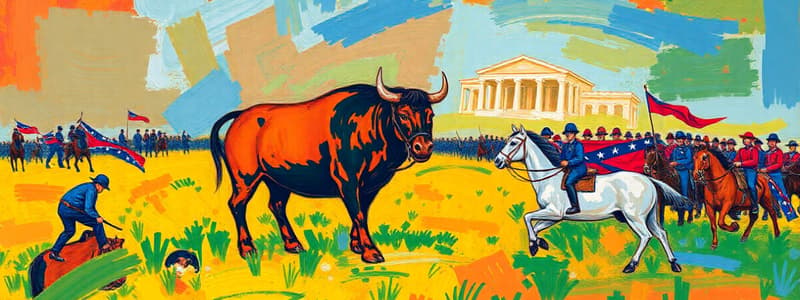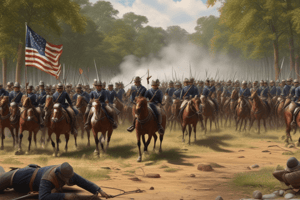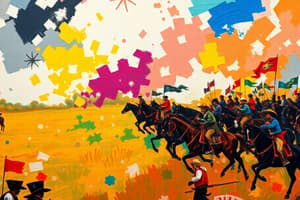Podcast
Questions and Answers
The First Battle of Bull Run took place in what year?
The First Battle of Bull Run took place in what year?
- 1861 (correct)
- 1860
- 1865
- 1863
Who was the president of the United States when the Civil War began?
Who was the president of the United States when the Civil War began?
- Andrew Jackson
- Abraham Lincoln (correct)
- Jefferson Davis
- James Buchanan
Which side won the First Battle of Bull Run?
Which side won the First Battle of Bull Run?
- The Confederacy (correct)
- The Union
- Neither side won
- It was a tie
What was the initial Union objective in the First Battle of Bull Run?
What was the initial Union objective in the First Battle of Bull Run?
What nickname was given to General Thomas Jackson after the First Battle of Bull Run?
What nickname was given to General Thomas Jackson after the First Battle of Bull Run?
Which of these factors was a significant advantage for the Union?
Which of these factors was a significant advantage for the Union?
What was the name of the Union army involved in the First Battle of Bull Run?
What was the name of the Union army involved in the First Battle of Bull Run?
What geographic feature was central to the fighting at the First Battle of Bull Run?
What geographic feature was central to the fighting at the First Battle of Bull Run?
What was the name of the Confederate army positioned near Manassas Junction, Virginia?
What was the name of the Confederate army positioned near Manassas Junction, Virginia?
What role did civilians play during the First Battle of Bull Run?
What role did civilians play during the First Battle of Bull Run?
Flashcards
First Battle of Bull Run
First Battle of Bull Run
The first major battle of the American Civil War, fought on July 21, 1861. It was a Confederate victory that showed the war would be long and bloody.
Jefferson Davis
Jefferson Davis
The president of the Confederate States of America during the Civil War.
Anaconda Plan
Anaconda Plan
A military strategy designed to slowly strangle the South by blockading its ports and seizing the Mississippi River.
P.G.T. Beauregard
P.G.T. Beauregard
Signup and view all the flashcards
Irvin McDowell
Irvin McDowell
Signup and view all the flashcards
"Stonewall" Jackson
"Stonewall" Jackson
Signup and view all the flashcards
Manassas Junction, Virginia
Manassas Junction, Virginia
Signup and view all the flashcards
75,000 volunteers
75,000 volunteers
Signup and view all the flashcards
Study Notes
- The First Battle of Bull Run, the Civil War's first major battle, occurred on July 21, 1861.
- Around 60,000 men gained their first combat experience at Bull Run.
- The Confederate victory at Bull Run stopped the initial Union attempt to seize Richmond.
- It demonstrated the war would be longer and bloodier than anticipated.
Background
- Following his presidential win in 1860, southern states seceded, forming the Confederate States of America in February 1861.
- Lincoln faced the secession crisis upon inauguration on March 4, 1861.
- Lincoln aimed to act without provoking more states to leave the Union, believing secession was illegal.
- Fort Sumter became a test when its commander, Major Robert Anderson, refused Confederate surrender orders.
- Lincoln's decision to resupply the fort led to Confederate forces opening fire on April 12, 1861, marking the start of the Civil War.
The War Effort Ramps Up
- The Confederate attack on Fort Sumter allowed Lincoln to request troops.
- Lincoln called for 75,000 volunteers to defend the Union.
- Virginia was among the four states that then seceded from the Union.
- Washington was vulnerable as recruits needed time to organize.
- Lincoln sent troops to Baltimore over pro-secessionist issues.
- The Army of Northeastern Virginia was formed in Washington, under Brigadier General Irvin McDowell.
- McDowell divided and trained the army.
Confederate Organization
- After Virginia's secession, the Confederate capital moved to Richmond.
- Jefferson Davis started building a Confederate army before Fort Sumter.
- Recruitment of 600,000 volunteers was approved by May.
- The Army of the Potomac, led by Brigadier General P.G.T. Beauregard, was stationed near Manassas Junction, Virginia.
- Brigadier General Joseph E. Johnston commanded a second army, the Army of the Shenandoah, in Winchester, Virginia.
- The South's defensive position was a strategic advantage.
- The Union had advantages in population and industry.
- General Winfield Scott proposed the Anaconda Plan: blockading ports and seizing the Mississippi River.
- Though initially mocked, the Anaconda plan was eventually adopted.
First Battle
- By early July, McDowell had 35,000 men, facing pressure to attack Beauregard.
- McDowell delayed due to his troops' inexperience, but Lincoln insisted.
- On July 16, McDowell's army marched towards Manassas Junction.
- McDowell aimed to defeat Beauregard before Johnston's arrival.
- Johnston moved his army by train to assist Beauregard.
- The armies were roughly equal in size when McDowell prepared to attack.
Location
- The First Battle of Bull Run took place near Bull Run Creek and Manassas Junction, west of Centreville, Virginia.
- Control of the junction was important for controlling supply and troop movement.
- Beauregard and Johnston defended Manassas Junction along Bull Run.
- McDowell planned to capture Richmond by seizing the junction.
- The Union named battles after creeks or rivers while the Confederates used nearby towns or railroad junctions, hence the name First Battle of Manassas.
The Start
- On July 21, McDowell sent two divisions to attack the Confederate left flank at Sudley Springs Ford.
- The rest of the Union Army feigned attacks at Stone Bridge and Mitchell's Ford to distract Beauregard.
- McDowell's artillery opened fire on Confederate positions at Stone Bridge at 5:30 A.M.
- Colonel Nathan Evans shifted his men to counter the main Union threat.
- The Union march was delayed, with crossing at 9:30 A.M., allowing Evans to take a defensive position on Matthews Hill.
- Despite reinforcements, the outnumbered Confederates were pushed back.
How the Battle Turned
- General Thomas Jackson's Virginia brigade arrived on Henry House Hill.
- General Bee's call to rally behind Jackson led to his nickname "Stonewall".
- A pause for Union reorganization enabled more Confederate troops to reinforce Henry House Hill.
- Confederate counterattack on the Union's right flank resulted in a Union retreat.
- The Union retreat turned into a rout due to civilians blocking the road to Washington.
- By 4:00 P.M., the battle ended with a Confederate victory.
Aftermath
- Confederate armies were unable to pursue the routed Union Army.
- Washington was fearful of a Confederate attack.
- The South gained morale and confidence from the victory; Jefferson Davis hoped they would gain foreign allies.
- Expectations of a quick Union win disappeared.
- Both sides realized the war's potential difficulty and bloodshed after seeing the casualties.
Casualties
- Union casualties: 480 killed, 1000 wounded, 1200 missing, totaling 2680.
- Confederate casualties: 390 killed, 1600 wounded, 12 missing, totaling 2002.
- McDowell lost 9.5% of his force, while Beauregard and Johnston lost 6.5%.
- The casualties woke the nation up to the realities of the conflict.
Next Steps
- Lincoln signed a bill for 500,000 more men the day after the battle.
- General McDowell was replaced by Major General George B. McClellan on July 25.
- McClellan reorganized and trained the army in Washington, renaming it the Army of the Potomac.
- Davis called up another 500,000 volunteers.
- Joseph Johnston commanded when the army saw battle in the spring of 1862.
- Robert E. Lee replaced the wounded Johnston in May 1862.
- The Army of the Potomac and the Army of Northern Virginia were larger and better trained than those at Bull Run.
- Stonewall Jackson became Lee's main corps commander.
Studying That Suits You
Use AI to generate personalized quizzes and flashcards to suit your learning preferences.




